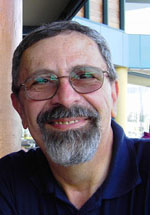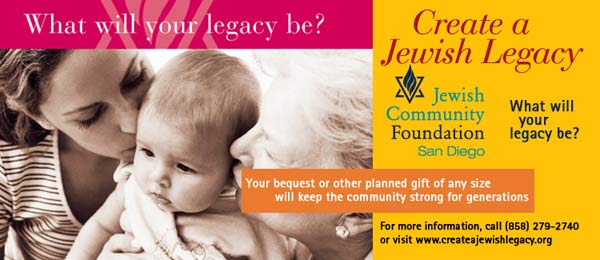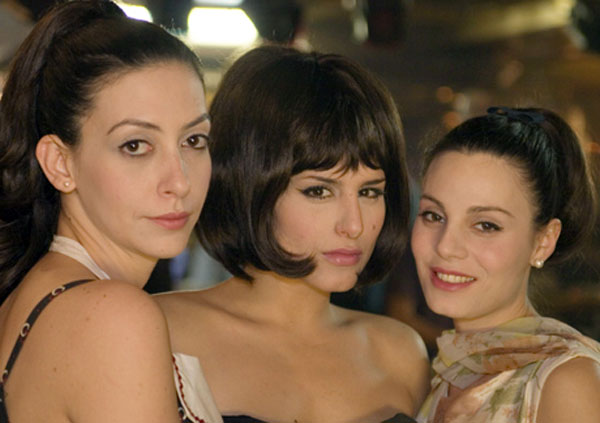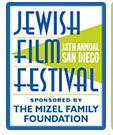| |
|
THE JEWISH CITIZEN
San Diegans bid farewell to Rose Schiff, matriarch to performers and educators
By Donald H. Harrison
 CANBERRA, Australia—While reading Alan Rusonik's article (SDJW Feb 6 2008) about being a "closet genealogist" and how important it is for children to know about their connections and their past I found myself nodding violently. I became convinced it was time for me to reveal to the world that I share his "closet" obsession. CANBERRA, Australia—While reading Alan Rusonik's article (SDJW Feb 6 2008) about being a "closet genealogist" and how important it is for children to know about their connections and their past I found myself nodding violently. I became convinced it was time for me to reveal to the world that I share his "closet" obsession.
I am not sure how I started out on this road, but I am positive it had something to do with the death of my parents.
When my mother passed away, I was left with the problem of dealing with not only her passing, but also my childhood home, the stuff that my parents had accumulated during their lives in Australia and some things that somehow they had managed to resurrect from their lives from the times before I was born.
Wading through the paper work and seeing what they had written was laborious at first - especially as it involved trying to make sense of what was important and what was not.
Then it became fascinating.
I don't think I consciously realised, up to this point, that when I read a book or went to a movie or a play, often I was actually experiencing life through the lens of another human being who had perhaps created fiction for public consumption, but who had drawn on his or her own experiences.
Now I realised with a suddenness that was almost overwhelming, I was actually able to glimpse some parts of my parents' lives through their documents, their photos and their letters. There was stuff I was totally unaware of such as their childhood, their adolescence, their young adulthood and the highs and lows of their journeys through life.
One of the most poignant stories in all of this material concerned my mother's experience of the Holocaust. Like many others in Hungary who had been born in the countryside but moved to Budapest she was taken by train to Ravensbrück Concentration camp and from there was transported to an underground facility at Venusberg where the Nazis were making something military - parts of the V2 rocket according to my mum.
All of a sudden, her notes mentioned that she had been transported to Mauthausen and then noted that she had been freed when the camp was liberated and that was IT!
However along side of this information were an identity card from when she was transported out of Budapest, an identity card with which she was issued by the liberating American forces, a note from a n American doctor who had seen her at Mauthausen that declared that she was over her Typhoid fever and some other documents that related to this period in her life.
I have to confess, I was so intrigued by these little snippets, that I spent a lot of time trying to figure out how to find out more.
It was at this point that I discovered genealogy and started on that road of discovery that especially these days, can be both fascinating and facilitated by the volume of information which one can find on the Internet. Back when I started my interest I actually had to travel overseas and make appointments with people in archives, libraries and other locations to see if I could search for things. These days it's a little easier as much more information is becoming available on the Internet.
There is a general warning that I have to give to readers though. Once you start on this road you MAY become so involved that the need to find out more will become a craving. Thankfully this is NOT one of those addictions that are illegal, but I do warn readers that it can be unbelievably time consuming and that once started you may become obsessed!
I would specifically suggest to any reader that he/she, if interested, gathers as much data about the parents and their children and their parents and their children as possible and then visits JEWISHGEN
This is the home of Jewish Genealogy and a wonderful place to start your research and also a wonderful place to contribute time to unravelling some of the paperwork which exists by translating (if you have the skills) by transcribing (if you have the time) and in a hundred other ways.
But I digress.
Imagine if in this journey of discovery you can find something like this: (I have taken the liberty of shortening the names to just initials to protect other family members who may be upset to see their information more generally available)
"In 1944,the Hungarian government which had maintained a form of independence from Germany and had managed to tread its own course, was invaded by the Nazi Germans and capitulated to the demand to segregate Jews into a Ghetto and to pitch them headlong into the 'final solution'.
Up to that time fully 25% of the population of Budapest had been Jewish.
Nyiregyháza (the town where my mother was born) was stripped of its Jews who were, for the most part, taken to Auschwitz.
The Jews of Budapest were treated a little differently. Some remained in the ghetto in Budapest while many had a similar experience to K. (my mother)
The following documentation was found and translated from the original Hungarian:
From the National Office of the Hungarian Israelites of 12 Sip Utca Budapest VII Number 4166/957 Budapest 15 July 1957 addressed to Mrs L G nee K G Sydney which states:
"Upon your request and on the strength of the documents, evidence of the committee of tenants and depositions of witnesses we certify, that you, born on the 16th of February 1920 at Nyiregyháza, mother's maiden name Irén F, have been obliged to wear the discriminating yellow star since the coming into force of the anti-Jewish law in April 1944, and that you lived in one of the houses assigned to the Jews and marked with a star, then on the 23rd of October you were brought from the KISOK grounds to Isaszeg and from there to the brick factory of Obuda, to be deported to Ravensbrück, Venusberg and Mauthausen, from where you were liberated on the 5th May 1945. We further certify that your father, Dr. A G, born 1884 at Beregszász, mother's name H S was carried off by the fascists from his lodgings on the 20th October 1944 as forced labourer to Csomád, where he was shot."
On 22 November 1944 K G was taken, along with many others, from their homes in Budapest, to the brickyard in Buda and from there they were transported on Sondertansport Nr.123 to Ravensbrück.
[Note: Information by courtesy of the Stiftung Brandenburgishe Gedenkstätten - Mahn und Gedenkstätte Ravensbrück
Ravensbrück was a very large concentration camp mostly for women prisoners and it was here that the German authorities determined which slave labour or death camp the prisoners were to be dispatched.
No doubt she was kept there until a decision was made about where to send slave labour. In her case the decision seems to have been made to go to Venusberg.
In notes K kept she indicated that she was certain that they worked on the V2 rocket program at factories and or near the camp.
There is historical evidence only for the Messerschmidt factory which was operational in Venusberg and so either there was a secret program which has not as yet been revealed (unlikely) or she was mistaken about the components she was being asked to put together for the Germans and they were actually Messerschmidt 109 or 296 parts.
It is likely that she thought that she had worked on the V2 program because of what she heard in Mauthausen when she arrived there in 1945.
This anecdotal evidence is supported by the following article from the Mauthausen Memorial web site in which the following is written about the Wiener Neustadt satellite camp:
"In 1943 the authorities decided, in line with the "aboveground transfer of production sites" of the armaments industry, that the Rax-Werke at Wiener Neustadt, which then produced engine tenders, should become a production site for the A4 ("V2") rockets. Until 1943, Wiener Neustadt remained outside the reach of allied airplanes.
In the main production building of the Rax-Werke, the "Große Serbenhalle", (a large plant 300 meters long, 70 meters wide, and 30 meters high that had been disassembled in Serbia in order to be reassembled at Wiener Neustadt), the production of components for "V"-rockets (V=Vergeltun, engl: retaliation) began in July 1943. Originally, it was also planned to assemble rockets there. However, by November 1943, only 24 rocket "mid-sections" had been manufactured.
The satellite camp at Wiener Neustadt, official name "SS-Arbeitslager Wiener Neustadt", was founded on June 20, 1943. On that day, about 500 prisoners from the main camp arrived at Wiener Neustadt, on October 8, 1943, another 772 prisoners were transported to the camp. They were interned in an annex of the big "Serbian plant", and initially worked on the completion of the plant. Later they mounted machines and installations for the production of rockets.
After the first air raids on Wiener Neustadt, the transfer of production to underground facilities was considered. As a first measure, the production of oxygen was transferred to the cellars of the Zipf brewery, where, at the same time, a new camp for prisoners was founded: the satellite camp "Schlier-Redl-Zipf".
In November 1943, after repeated air raids in the course of which the Rax-Werke, too, were hit, the production of A4 ("V2") rockets was discontinued. At the same time, the satellite camp Wiener Neustadt was closed, with some of the prisoners being transferred to Redl-Zipf, and others transported to the concentration camp Dora-Mittelbau, which was affiliated with the "Mittelwerke" in Nordhausen, where serial production of the A4 ("V2") rockets was now underway.
At the end of May 1944, the Rax-Werke started production of small ships: "Marine-Artillerie-Leichte". Again, a satellite camp was erected. The first 300 prisoners from Mauthausen arrived at Wiener Neustadt on July 5, 1944. Between 500 and 700 prisoners had been interned at the camp until its closing and the evacuation of its prisoners to the Steyr satellite camp in end of March 1945."
K spent the winter of 1944 in this camp and I suspect that her youth, the fact that the Germans wanted to ensure that their weapons program was not unduly interfered with and did not wish to kill off their prisoners as quickly as was the case elsewhere are the only reasons that could explain her survival during this period.
There are some stories which she related about her travails in this environment. For example, she said that she would forever recall her mother's nagging as a child about eating her vegetables. When she refused or made a fuss about this, she recalled, her mother would warn her that one day she would be grateful to have such food available to her.
At the time she recalled that she dismissed these warnings, but had cause to remember them, as she and other prisoners fought for scraps of bread and potato peelings, during the time she was a prisoner.
There were stories of the beatings that the prisoners had to put up with and stories of the women who were convinced to become barracks leaders and who cooperated with the Nazis in the hope of some better treatment and then made the lives of their fellow prisoners even more miserable than would perhaps otherwise have been the case.
She records that she suffered from cold and hunger during this period. Before she died in Sydney during her last few days in hospital she also indicated that there was considerable brutality from the SS who were in charge of the camp.
The records show that at the end of April 1945 there was a train load of female prisoners removed from Venusberg and transported to Mauthausen. Of the 2,200 women on board only around 200 survived the journey. Given that the Mauthausen camp was liberated by the American 11th Army on May 5 1945 there is a very good chance that K G was one of these prisoners. I have not as yet been able to locate the actual list of names of all those on board, (the Germans were meticulous in their record keeping) but the timing is so relevant that I have chosen to believe she must have been one of these few prisoners who survived the journey
K stated that when she arrived in Mauthausen she had suffered from typhoid fever and given that the camp was equipped with a gas chamber and was not known for its clemency to its prisoners she feared that she would die. However since I have found a note from Dr H, an American army doctor, dated 16 May 1945 which states that she is "healthy and without infectious illnesses". it would seem that she made a relatively quick recovery following the American liberation of the camp no doubt due to the medicines that they provided
One of the Americans who liberated the camp and was placed in charge of the medical facilities has left this record behind in 1992 during a one hour video interview:
An only child,Gotz was born in 1913 in Moscow, Russia. He grew up in a Jewish home. His father, who worked as an engineer, passed away in 1919, and Gotz moved with his mother to Riga, where she worked as a physician. At the age of ten, Gotz was sent to Berlin to attend high school.
Afterward he studied medicine at the university in Pisa, Italy, where he graduated in 1939. He states that he did not experience any anti-Semitism at all during his time in Italy.
In 1940 Gotz immigrated to the United States in order to continue his education. In 1943 he volunteered for the U.S. Army medical corps and joined the 11th Army as a medical officer. On December 20, 1944, he was shipped to France together with his unit, which then proceeded through France and Germany toward Austria. In May 1945, Gotz was involved in the last battles in the Upper Austrian capital Linz before his unit moved along the Danube to the west.
On May 5, the 11th Army liberated the Mauthausen concentration camp, and Gotz was placed in charge of the medical treatment of the camp's survivors.
Gotz remembers that he heard music while approaching the camp. The camp's inmates had forced those German soldiers who did not manage to escape in time to play some typical Nazi songs. He also saw the dead bodies of German guards at the entrance of the camp; they had been lynched by the survivors. But as soon as he entered the camp, Gotz encountered the real horror of Mauthausen: He saw piles of bodies of the camp's prisoners, which had been prepared for being burned in the crematorium; he saw the gas chamber, where thousands of inmates had been annihilated; he saw the camp's quarry, where thousands more had been mistreated, killed, or worked to death; he saw the big chains on the wall, where prisoners had been put in irons and mauled to death by the dogs of the guards.
Within the barracks, American soldiers found many prisoners, who were not able to walk. He encountered sixteen different nationalities in the camp, about 20,000 inmates were still alive, but most of them were in terrible condition. He states that for another week after liberation,about 200 inmates continued to die every day. The majority of the survivors were non-Jewish, because most Jews, who the Nazis considered as not able-bodied for work, had been exterminated.
Gotz heard that the Jewish prisoners had been treated worse than the Gentile inmates. The American army used bulldozers to dig huge ditches in order to bury the dead inmates. U.S. soldiers forced people of the local population to carry the bodies to the graves.
On the second day after the camp's liberation, Gotz met a Jewish prisoner who wanted to sell him some of his drawings to make enough money to be able to leave the camp immediately. Years later, Gotz learned that this prisoner was Simon Wiesenthal. After the war, Gotz returned to the United States.
Information:
Date: May 28, 1992
Interviewer: not identified
Length: 1 hour
Format: Video recording
Alas his memory or the recording of his memory is in slight error as it was in fact elements of the US 11th Armoured Division that liberated the camp
There are a number of sites which can be considered when looking for information about Mauthausen or its nearby camp complexes for example:
http://www.gusen.org/
http://www.jewishgen.org/ForgottenCamps/Camps/GusenEng.html
http://www.jewishvirtuallibrary.org/jsource/Holocaust/mauthtoc.html
http://www.thirdreichruins.com/gusen.htm
http://www.nizkor.org/hweb/camps/gusen/gubh001x.htm
http://www.scrapbookpages.com/Mauthausen/KZMauthausen/Subcamps/Gusen01.html
http://www.geocities.com/CapeCanaveral/1325/berg.htm
http://www.royal-signals.org.uk/10/camp-concentration-mauthausen.html
With her identity papers ( I actually have found these among the papers and of course made them available on line to family members) K finally managed to leave the camp and walk all the way through Austria and Czechoslovakia back to Budapest to be reunited with her mother.
I sincerely hope that this small bit of information from my own genealogical research will encourage others to find out more about their family and ask those who are alive NOW to tell them their stories and then record them.
Trust me - trying to find the same stuff that they can tell you now, by digging through archives, will not only take a lot longer and indeed may not even be possible.
My continuing regret in my own search for my roots has been that I did NOT take the opportunity to talk to my parents more when they were alive about these things and that I did not listen when they tried to tell me things about themselves.
Please do NOT make my mistakes! They can be the cause for regrets that are incapable of any resolution later!



SAN DIEGO JEWISH FILM FESTIVAL
When triplet sisters become mothers
By Donald H. Harrison
SAN DIEGO—Rucha, who works at a video production company called "This Is Your Life" is surprised in the movie Three Mothers when one of her aunts, Yasmin, who is in failing health, comes by to tell a story filled with dark family secrets.
Rucha (Tali Sharon) is the biological daughter of Rose (Gila Almagor), but Yasmin (Tracy Abramovich) and another sister, Flora (Rivka Roz), joined Rose in raising her, concealing until now the reason for the breakup of their own families. Yasmin's visit prompts Flora to also decide to make a video telling the family secrets, and finally, Rose too, comes in to the office for a tense discussion with her daughter.
While revealing the story of the Hakim sisters—whose births as triplets in Alexandria, Egypt, was so notable that King Farouk himself posed with the parents and children—Three Mothers also is a vehicle for noted Israeli singer Gila Almagor, who portrays Rose in her 60s and who provides the vocals throughout the movie. Combining a plot and a concert on film stretches the running time of Three Mothers to 108 minutes, but nine Israel Academy nominations testify that the 2006 film by Dina Zvi-Riklis has its fans.
 The movie will be presented at the 18th Annual San Diego Jewish Film Festival on Saturday, Feb. 9, at 6:15 p.m. at the UltraStar Mission Valley and on Sunday, Feb. 10, at 7:30 p.m. at the AMC La Jolla. The latter screening will also be the occasion for a tribute to Marla Bennett, the San Diego student who was among the victims of the bombing of the cafeteria at Hbrew University in 2003. The movie will be presented at the 18th Annual San Diego Jewish Film Festival on Saturday, Feb. 9, at 6:15 p.m. at the UltraStar Mission Valley and on Sunday, Feb. 10, at 7:30 p.m. at the AMC La Jolla. The latter screening will also be the occasion for a tribute to Marla Bennett, the San Diego student who was among the victims of the bombing of the cafeteria at Hbrew University in 2003.
As this is a mystery, one dares not give away too much of the plot. But we can say this: ever since Genesis, Jews have been fascinated by stories of childless women and their relationships to those who can have children. If a couple who is childless feels envy for a couple with children, how much more complicated can their relationship be with a couple who have been privileged with multiple births?
Throw into this multi-generational saga a story of immigration from Egypt to Israel following the overthrow of King Farouk, as well as actual footage of the visit of Anwar Sadat to Jerusalem many years later, and one gets a sense of the conflicting emotions refugees can feel about their former homelands.


 . .
SAN DIEGO JEWISH WORLD THE WEEK IN REVIEW
Donald H. Harrison in San Diego: First graders receive siddurim in special presentation at Hebrew Day School
Natasha Josefowitz in La Jolla, California: Reading, writing, counting and speaking —are we as competent as we should be?
Dorothea Shefer-Vanson in Mevasseret Zion, Israel: Israeli school ceremony celebrates pupils demonstrating their reading of Bible
Ira Sharkansky in Jerusalem: Why Israel prefers to just muddle through
Carol Davis in San Diego: Works by Young Playwrights impressive
Donald H. Harrison in San Diego: Field Notes: A 17-Mile Drive kind of novel
Alan Rusonik in San Diego: Why genealogy is important for children
Plus: Super Tuesday results, State by State
Shoshana Bryen in Washington, D.C.: U.S. winning Al Qaeda's strong horse derby
Cynthia Citron in Los Angeles: The Monkey Jar riddle: who’s the monkey?
Donald H. Harrison in San Diego: Eternal Light documentary highlights one of the more meaningful television series
Ira Sharkansky in Jerusalem: Palestinians, Labor have penchant for self-inflicted political damage
Michael C. Abrams in San Diego: Mensch in full, Rabbi Leonard Rosenthal celebrated on 20th year at Tifereth Israel
Peter Garas in Canberra, Australia: 'Retarded' bombers story raises suspicions
Donald H. Harrison in San Diego: The likely GOP choice for vice president
Rabbi Leonard Rosenthal in San Diego: Torah portion on slavery quite troubling
Sheila Orysiek in San Diego: How far does community responsibility go?
David Strom in San Diego: Two brothers trying to survive together
Marsha Sutton in Del Mar, California: Mother’s death: A most Jewish moment
Shoshana Bryen in Washington, D.C.: What is justification for providing Syria with border surveillance computers?
Donald H. Harrison in San Diego: Life under Coney Island's roller coaster
subject of Jewish Film Festival short
Rabbi Baruch Lederman in San Diego: The sixth aliyah that the congregation—and its gabbai and visitor—would never forget
Rabbi Danny Schiff in Pittsburgh, Pennsylvania: Jews should support Ma legislation to ban body exhibits without consent of deceased
Ira Sharkansky in Jerusalem: Which zealots block Middle East peace?
< BACK TO TOP
Copyright 2008 - San Diego Jewish World, San Diego, California. All rights reserved.
|
|
